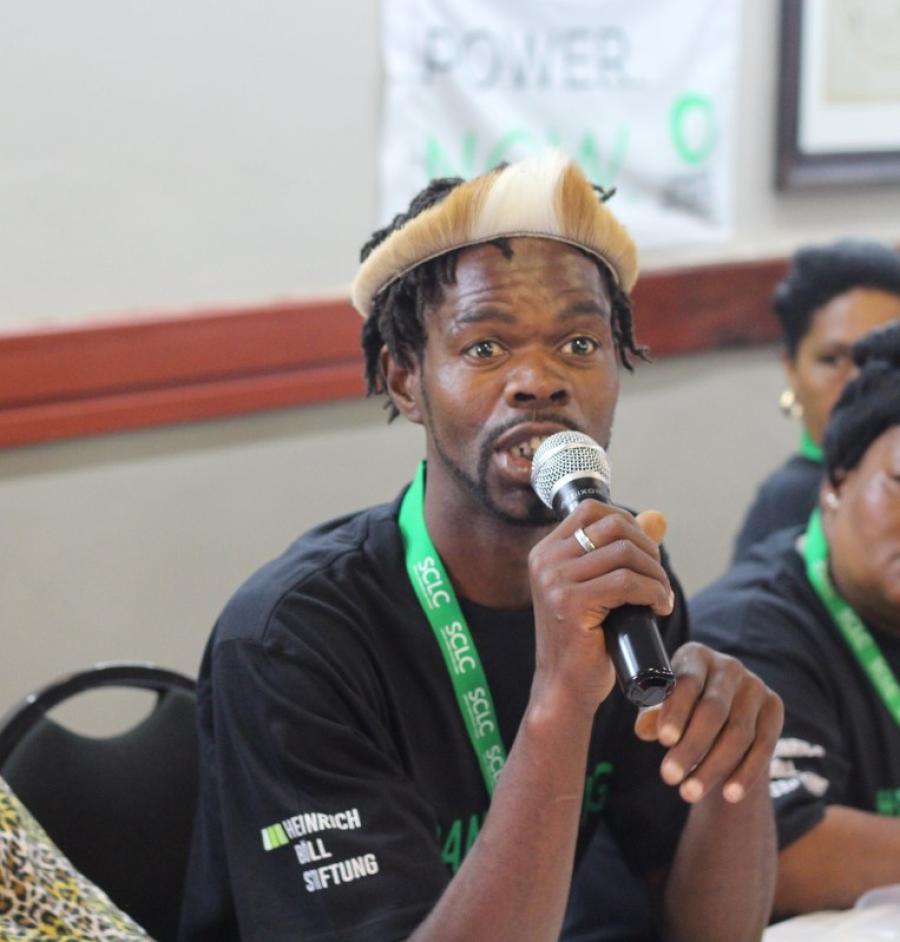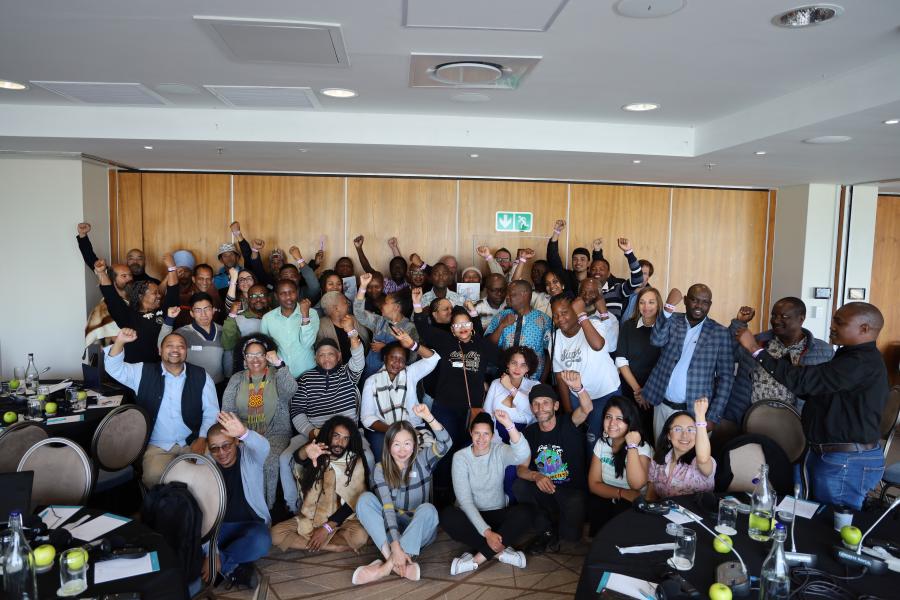The future San Culture and Education Centre (!Khwa ttu) is located on a former wheat farm some 40 miles north of Cape Town, in the vicinity of the Atlantic village Yzerfontein. The rugged beauty of the mostly undeveloped West Coast is well known to visitors who come to admire the flowers in September, when carpets of color cover the windblown hills and rim the dunes on isolated beaches. At first sight, it seems an unlikely destination in which to gain familiarity with San people and culture, but the region’s history reveals that this was once part of the vast territory of the !Xam Bushmen, who were systematically rounded up and exterminated by the Dutch trekboer commandos in the late 18th century. In honor of the area’s first inhabitants, the WIMSA1 General Assembly of 2000 renamed the farm, changing the name from "Grootwater" (Afrikaans for big water) to "!Khwa ttu," the term for water or water-pans in the language of the !Xam.
Initial discussions about opening a crafts outlet for San products in the Cape Town area date back to 1988, when San leaders and the Board of SASI (South African San Institute) were confronted with an ever-increasing tourist invasion. Overseas visitors (the new age fauna), filmmakers, and assorted entrepreneurs were invading remote Bushmen communities with demands that San act like "wild Bushmen" or pose with consumer products in commercials. Two upscale game resorts (Kagga Kamma in the Western Cape and Intu Afrika in Namibia), euphemistically advertised as ecotourism, made large profits by luring tourists to staged encounters with Bushman families who posed and danced on demand, clad in traditional loincloth. SASI’s lawyer, Roger Chennells, had repeatedly but unsuccessfully tried to make the resort owners sign equitable contracts with the two San groups. "If there was a possibility for the San to escape tourism we would definitely support the idea," said WIMSA Coordinator Axel Thoma in 1998, "but there is no escape, we must do something to avoid further exploitation."
The present site, !Khwa ttu farm, was purchased in February 1999 with donor money from Switzerland and incorporated into a nonprofit company. The location inspired the development of a concept more ambitious than the mere sale of crafts. !Khwaa ttu will restitute and display the heritage of the San as contained in their oral history, culture, visual arts, folklore, cosmology, and language. It will educate the general public, as well as the uprooted San themselves, about the cultural legacy of the Bushmen. It will provide training and adult education--including skills in tourism, entrepreneurship, and community-based development--for rotating groups of San. At the San’s request, the farm will also remain a "research free zone"--a place to reverse the role so many indigenous groups have played as objects of study. The San will seek knowledge and will ultimately teach a wider public there.
The Site
The farm covers 800 hectares (over 1,900 acres) of open land with magnificent views. The site’s beauty, its excellent access from Cape Town by road, and the layout of its sturdy, simple buildings almost imposed future functions and activities. A vast craft and training center, four San cottages, a restaurant, offices, a shop, a house for the manager, a museum, and a separate unit to display copies of rock art were established there, and many outdoor activities are held on the grounds. Some 30 antelopes are already roaming the land, which is being cleared of alien plants. It may take a few years for the indigenous flora to regain prominence.
As with any project of this size, success depends on enthusiasm, but also on competent and persevering management. Michael and Bets Daiber, a young South African couple trained in anthropology and with years of experience working intimately with the San, were persuaded to assume the daunting task. All buildings were in need of repair and are presently being renovated according to the plans of Cape Town architect Nicola Irving. The male San trainees are not only involved in the general maintenance of the farm (water pumps, roads, and vehicles), but have built miles of games fences, erected a gate, and are increasingly involved in the renovations of buildings.
!Khwa ttu strives to transmit new skills to the San trainees--skills that will enable them to seek employment or start projects of their own once they return home. Bets Daiber’s days are filled with English communication courses, special crafts projects for the women, and individual casework to help the shy, uneducated female trainees gain confidence through new skills. The young Centre has benefited from the generous support and advice of many local individuals and institutions; Tessa Graaff of the Montebello Design Center, for example, shares her extensive expertise. AIDS education and TB tests for every trainee are part of the routine medical care provided by local doctors. Concepts of nutrition and childcare are on the agenda; two healthy San babies have been born on the farm. WIMSA pays a salary to every trainee; they then return home after a few months, encouraged by new skills, confidence, and small savings.
Present and Future Challenges
At times, a project such as !Khwa ttu seems as daunting as stopping the ocean. How can it benefit 100,000 San in southern Africa? Education is a focus of the Centre, which is due to open to the public in 2003 and must then manage to achieve self-sufficiency through sales of crafts, meals, and tickets. All stakeholders are aware that its financial success will depend on the image of South Africa as a safe travel destination; local tourism and donations alone would not generate sufficient income for the Centre to operate.
Another challenge will be securing the project against unfriendly take-over attempts, either by San or by outsiders. While most San are not competitive or business-savvy--which comes as no surprise in view of their tragic history--they increasingly seek to understand the mechanisms of politics and law. The leap from abject poverty and total dependence to control over a major tourist attraction has severely challenged indigenous communities in other countries.
But the San are aware of the importance of their culture and heritage--they see others benefiting from it. Lawyer Roger Chennells discusses issues of intellectual property with San groups (see page 51). SASI’s linguist, Nigel Crawhall, is not only working on local San language revival projects, but has gained the trust of San leaders, who are beginning to see the link between language, history, and rights to land (see page 49). The new momentum of "Khoisan" politics in South Africa--the recent claim, for example, that the country’s exquisite rock art should be the heritage not only of the descendants of the Bushman people who painted it, but of varied, often opportunistic cultural entrepreneurs--adds pressure on the San to come to terms with their own history and heritage. Some San have thus come to see research in a new, semi-positive light, and will increasingly want to control it for their own vital interests. The future museum will strive to repatriate images and testimonies of the different Bushman peoples that are now scattered in museums and universities around the world. There will be no lack of work for !Khwa ttu in years to come.
Endnotes
1. Working Group of Indigenous Minorities in Southern Africa, based in Windhoek.



